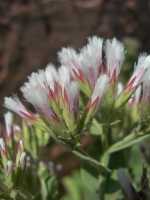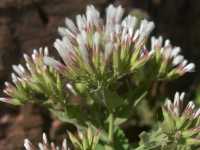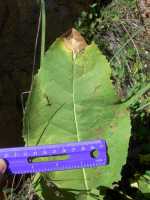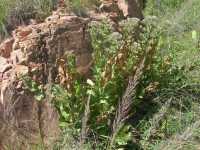Plants 40-150 cm (stems sulcate to striate distally, densely glan-dular). Leaves cauline and/or basal; sessile; blades ovate to ovate-elliptic, 1.5 (cauline)-18 (basal) cm, bases shortly sagittate or clasping, margins acerose-denticulate, faces densely glandular-puberulent. Heads in subcongested corymbiform arrays. Involucres obconic to campanulate, 7-9 mm. Phyllaries in 2-3 series, oblong-oblanceolate, apices acuminate, abaxial faces densely glandular-hairy. Receptacles alveolate, glandular. Florets 3-6; corollas lavender-pink (purple), 7-12 mm. Cypselae subcylindric to subfusiform, 3-7 mm, glandular; pappi bright white, 8-9 mm (rigid). 2n = 54.
Flowering Oct-Nov. Gravel and caliche soils in warm Sonoran desert scrub; 100-200 m; Ariz.; N.Mex.; Mexico (Chihuahua, Durango, Sonora).
Duration: Perennial
Nativity: Native
Lifeform: Forb/Herb
General: Perennial herbs, 40-150 cm tall, with grooved, glandular, green stems.
Leaves: Sessile, basal and alternate-cauline, somewhat fleshy, firm and thick, ovate with toothed margins, the teeth armed with prickles.
Flowers: Flower heads narrow, clustered in dense corymb-like panicles; involucre (the ring of bracts surrounding each flower head) cone-shaped to bell-shaped, 7-9 mm high, the bracts in 2-3 series, narrow with acuminate tips, densely glandular-hairy on the outer surface; flowers 3-6 per head, all bisexual, the corollas bilabiate with 2 lobes on one side and 3 lobes on the other side, pinkish-purple, 7-12 mm.
Fruits: Achenes subcylindric-fusiform, glandular, 3-7 mm long, with a pappus of bright white hairs.
Ecology: Found on gravel and caliche soils in desert scrub communities, from 4,000-6,000 ft (1219-1829 m); flowers June-October.
Distribution: AZ, sw NM; south to c MEX.
Notes: The genus Acourtia in our region is distinguished by being erect perennial composites with woolly bases of brownish-bronze hairs; leathery, sessile or clasping leaves with toothed margins, the teeth often with prickles; and often showy heads with pink, purple or white flowers. A. thurberi is taller than A. nana and does not have round, holly-like leaves. It is more similar to A. wrightii, but differs by having more rounded, egg-shaped leaves; phyllaries (involucral bracts) with covered with stipitate glands; and fewer flowers per head (3-6 flowers, compared to 8-11 flowers in A. wrightii). Look for A. thurberi at the middle elevations in the mountains of southern Arizona, southwest New Mexico, and neighboring Mexico.
Ethnobotany: Unknown, but other species in the genus have uses.
Etymology: Acourtia is named for Mary Elizabeth Catherine Gibbes A-Court (1792-1878), while thurberi is named for Dr. George Thurber (1821-1890) a botanist on the Mexican Boundary Survey of 1850-1854.
Synonyms: Acourtia mexicana, Perezia thurberi, Perdicium mexicanum
Editor: LCrumbacher 2011, FSCoburn 2014, AHazelton 2015









